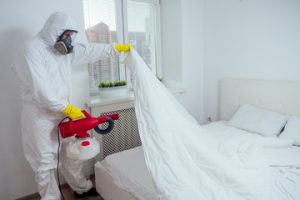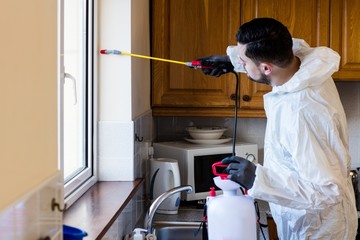Pests invade homes quietly and can cause unseen damage. They thrive in places we often ignore. Preventing infestations requires both vigilance and strategy. Modern pest control focuses on sustainability.

Understanding pest behavior is key to effective management. Each species reacts differently to chemicals and traps. Observing habits can prevent unnecessary treatments. This insight reduces environmental harm. Contact Port St Lucie Pest Control for professional help.
Integrated pest management is gaining attention. It combines chemical, biological, and mechanical approaches. Each method is chosen based on the specific situation. This minimizes resistance among pests.
Home inspections are the first line of defense. Professionals identify entry points and nesting areas. Early detection saves both time and money. Structural vulnerabilities often go unnoticed by homeowners.
Biological controls are now widely explored. Predators, parasites, and microorganisms target pests naturally. This method reduces reliance on harsh chemicals. It also supports ecological balance.
Climate changes affect pest populations. Warmer temperatures can accelerate breeding cycles. Certain insects are appearing in unexpected areas. Adapting pest control strategies is crucial.
Smart traps and monitoring systems are transforming management. Sensors detect movement and track infestation levels. Data-driven decisions allow precise interventions. This reduces overuse of chemicals.
Home hygiene plays a critical role in prevention. Food residues and standing water attract pests. Regular cleaning disrupts their survival cycle. Even small changes make a big difference.
Urban environments create unique pest challenges. Limited green spaces and dense structures favor rodents and insects. Tailored strategies are necessary for these areas. Standard approaches often fail in complex settings.
Chemical treatments are evolving to be safer. Low-toxicity compounds target specific pests with minimal environmental impact. This protects pets and beneficial insects. Education on correct usage is essential.
Some pests develop resistance quickly. Rotating chemicals and combining methods can counter this. Continuous monitoring ensures interventions remain effective. Ignoring resistance leads to recurring problems.
Rodent management is often overlooked but critical. Mice and rats carry diseases and damage property. Non-lethal strategies include exclusion and habitat modification. Humane methods are gaining popularity.
Pest control is not just reactive but also preventive. Sealing cracks and maintaining proper ventilation deters infestations. Landscaping can be adjusted to reduce pest habitats. Prevention is cheaper than treatment.
Emerging technologies include ultrasonic repellents and AI-guided systems. These tools complement traditional methods. They offer targeted, non-invasive solutions. Research continues to improve their efficiency.
Education for homeowners is vital. Understanding risk factors empowers proactive measures. Workshops and online resources help spread knowledge. Informed decisions reduce dependency on chemicals.
Waste management directly impacts pest populations. Trash accumulation attracts rodents and insects. Proper storage and timely disposal reduce infestations. Community-wide initiatives enhance effectiveness.
Water management is often neglected. Stagnant water attracts mosquitoes and other pests. Drainage and moisture control are key preventive measures. Regular inspections of plumbing and gutters help.
Seasonal shifts affect pest behavior. Spring may trigger termite activity while summer favors ants. Tailoring interventions to seasons increases success rates. Ignoring patterns leads to wasted resources.
Natural repellents are regaining popularity. Oils, herbs, and natural extracts discourage pests without harm. These methods are sustainable and eco-friendly. Consistency is crucial for effectiveness.
Professional collaboration strengthens pest control outcomes. Pest control experts, entomologists, and homeowners working together achieve better results. Shared knowledge improves decision-making. Communities benefit from coordinated efforts.
Pests also impact mental health. Infestations create stress and anxiety for residents. Timely intervention restores peace of mind. Holistic pest control considers both physical and psychological effects.
Storage practices influence pest presence. Dry goods, clothing, and furniture are often targeted. Using airtight containers prevents contamination. Proper rotation and inspection are equally important.
Landscape design can act as a barrier. Dense shrubs near homes attract pests while open, clean spaces discourage them. Selecting plants strategically reduces infestations. Combining design with monitoring creates an integrated defense.
Noise and light levels may influence certain pests. Some insects avoid well-lit or noisy areas. Adjusting environmental factors can reduce activity. This passive method complements active control.
Chemical-free fumigation is emerging in urban settings. Carbon dioxide and heat treatments target pests efficiently. These methods leave no residue. They are increasingly preferred for sensitive environments.
Pest control in agriculture shares principles with homes but scales differently. Crop rotation and natural predators minimize damage. Reduced pesticide usage improves long-term soil health. Integrated approaches ensure sustainability.
Community involvement strengthens pest prevention. Neighborhood clean-up drives reduce breeding grounds. Sharing resources and knowledge increases resilience. Collective action amplifies individual efforts.
Early detection tools are advancing rapidly. Motion sensors, cameras, and remote monitoring offer real-time updates. Quick responses prevent major infestations. Technology enhances traditional methods.
Understanding life cycles informs treatment timing. Targeting the vulnerable stages of pests maximizes effectiveness. Ignoring timing reduces success rates. Researching biology is a small effort with big returns.
Health considerations are paramount in chemical use. Protective equipment and proper dosing prevent accidents. Non-toxic alternatives should always be considered. Awareness ensures both human and animal safety.
Record-keeping aids long-term management. Tracking treatments, pest sightings, and environmental factors improves strategies. Patterns can indicate hidden problems. Data-driven approaches reduce recurring issues.
Climate-resilient solutions are necessary for the future. Droughts, floods, and temperature shifts influence pest populations. Flexible approaches allow adaptation. Preparation ensures control methods remain effective.
In conclusion, pest control has moved far beyond spraying chemicals. It now integrates technology, biology, and preventive strategies. Sustainable, humane, and informed practices are the future. A proactive approach ensures safer homes and healthier environments.
